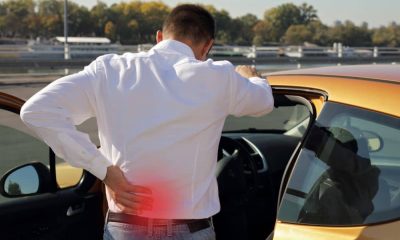Driving can be stressful. Road rage, traffic + the traffic light that just won’t change can be enough to send you over the edge. But, did you know that driving is one of the biggest causes of LBP, neck discomfort, and postural dysfunction that we see in practice?
I am Dr Jacinta Di Prinzio from Open Space Healing, Fremantle’s Hub for all things Chiropractic wellness and today, I will be giving you our best tips for improving your driving posture so you can stop asking “Are we there yet?”
Benefits of Good Posture When Behind the Wheel
Before we dive in, I think we should begin this by understanding why proper driving posture is essential. This way, it will motivate you to modify the wrong posture you probably have grown accustomed to.
You may already know that proper posture is essential. Still, many people tend to believe it only applies when they’re at home or the office. When they’re in a moving car, it gives them an excuse to slouch or sit however they want. And if you are among those people, I’m here to tell you it’s time to change that behaviour. Here’s why:
- You put more strain on the discs and vertebrae, especially when driving for long hours at a time.
- Foot cramps also result because of lousy driving posture.
- Repetitive driving injuries continue to rise in Australia.
- Long hours of driving can cause difficulty when you need to stand or even sit for other tasks.
- Poor posture of drivers is reported to cause other issues, including hand and finger cramps.
- Slouching when driving can contribute to accidents. People who have to drive for long distances feel sleepy when their backs are not straight. Holding your head up and maintaining proper driving posture can help avoid road accidents.
Time Magazine also published an article in 2014 claiming that driving for long periods can result in health conditions. These include increased blood sugar and cholesterol, hypertension, and a higher risk of depression and anxiety. These non-musculoskeletal conditions can be avoided if you limit your time behind the wheel. So, regardless of the number of hours you spend driving each day, you’re doing damage to your back and spine with your bad posture.
Driving and Your Back
What if you do spend several hours driving? Chances are you complain about back pain. You probably think it’s normal. After all, the Australian Institute of Health and Welfare (AIHW) states that one in six Australians or 16% of the total population, had suffered from back problems in 2017-18. And if you’re among those millions of people, then back pain isn’t a big deal, is it? Nope, you’re mistaken.
We all feel body pain from time to time, but frequent back issues should not be ignored. They are commonly associated with other conditions like bone or joint problems. Your connective tissue and back muscles, and nerves can also have problems. If you don’t fix your posture, regular driving can cause a more severe back issue that can lead to productivity loss or, worse, disability. And it probably doesn’t come as a surprise to you that those who suffer from chronic back pain are truck, bus, and taxi drivers. Those are people who spend the majority of their daily hours behind the wheel.
If you feel that nagging back pain and discomfort regularly, you could be dealing with something that may have already progressed into a chronic problem. It should be addressed immediately. While you can have your back adjusted, it makes sense to take the necessary steps to take care of it before it gets worse. So, what can you do? Apart from the perpetual “Elongate your spine” advice that we hear far too often, there are other things you can do aside from sitting up straight. Here are my tips that will help improve your driving posture:
Adjust Your Revision Mirror
Next time you get into your car, sit up nice and straight and adjust your revision mirror while incorrect posture. Now make sure you don’t move it! Use the revision mirror as a reminder to sit up straight instead of re-adjusting it to suit for slumped posture.
Invest in a Lumbar Support Pillow
If you get low back pain when driving, or you notice there is a gap between your lower back and the seat, it is worth investing in a lumbar support pillow. This will help support your lower back and spinal curves when you are driving.
Take Your Wallet Out of Your Pocket
Have you ever tried walking around with one orthotic in? Do you think your body might feel pretty average if you did that for a few hours a day? By sitting on your wallet, or anything in your back pocket, you are essentially doing exactly that! Remove loose items from your pockets to ensure your spine and pelvis are in correct alignment as you drive.
Relax Your Head Back
If you play Spotto, you are bound to see multiple people in their cars strangely the steering wheel and getting up close and personal with their front window. Don’t be like these people. Relax your head back, and release the tension in your arms. And don’t forget to think happy, patient thoughts when the traffic is making you antsy.
Take Regular Breaks
If you are driving for longer than an hour, it is wise to take regular breaks. Pullover, get out of your car, walk around for 5 minutes, and do some stretches and then return on your journey.
Your Car’s Role in Your Driving Posture
One important thing that most people forget is to select a car that’s right for them, especially their size and height. It’s not all about aesthetics and the features that convince you to buy the car. You should also consider the vehicle size and make sure it is suitable for you. You cannot drive around in a supermini and expect to be confident with your posture when you’re 208cm tall. That’s not going to help you attain a proper posture. Many cars don’t care whether the driver has a good sitting posture. It’s understandable since that’s not what they are designed for. But we have numerous options today, and some of them offer adjustable seats, steering columns, and other sections.
Now, I’m not saying you should buy a new car. If you are in the process of buying a new one, then I do suggest that you take my sincere advice. Please look into the adjustability and ergonomics of the vehicle you prefer. This is important and should never be overlooked. Here’s what you need to know about an ergonomic vehicle: Meanwhile, if you don’t have any plans to buy a new car, don’t worry. There are ways to help you improve your posture when driving.
Follow these steps:
- Push the car seat back.
- Lower it the farthest possible.
- Recline or tilt the back of the seat 30 to 40 degrees.
- If the steering wheel adjusts itself, move it all the way up towards the dashboard.
- Observe the result by sitting on the seat.
- If you can see the road and the instruments, you’re good to go and move to the next step. But if you can’t, you will need to adjust the seat height. It should not be too high that you end up bowing your head down or tilting to the side to see. If you think the seat is too low even when it’s already at the maximum height, you can add a wedge or cushion. I’ve discussed getting a lumbar support pillow earlier. It doesn’t just support your spine and back but also decrease vibrations that increase your risk of back pain, especially the lower back.
- Are you used to your knees touching the bottom of the car seat? If so, it’s time to change that. This position can give you bad knees and even impair your blood flow. Have a gap equal to at least two of your fingers between the seat and the back of your knees.
- Is your seat position appropriate? You will know if you can easily reach and step on all the foot pedals while your back is resting on the seat. If you have to move, you should adjust the seat forwards until you can completely depress the pedals.
- There should be a slight bend of at least 20 to 30 degrees in your knees when pressing on a pedal. Keeping your knees too straight can lead to knee pain.
- Next is to observe your feet. Are the heels relaxed on the floor when the balls of your feet touch the pedals? If yes, you’re doing it right! One foot should be able to move without any hindrance between the brake and accelerator when you place the heel before the brake pedal. Keep your other foot on the footrest when there’s no need to use the clutch. Doing so increases support to your back and pelvis. I have to mention that this is where automatic cars are a better choice for posture.
- The back of the seat’s inclination should be raised to an angle of about 100 to 110 degrees. When you’re sitting on this angle, you’re helping decrease the pressure on the low back discs.
- Aside from back pain, you could have some neck trouble down the road if you don’t modify your head’s position. Luckily, many car seats today have adjustable headrests. As much as possible, you should be able to adjust the height, as well as the front to back headrest position. Its height should allow your head to sit in the middle.
- Adjusting front to back is vital. Sit with your normal or neutral head position first, where you make sure your earlobes align with your neck muscles and collar bone. Don’t know your neutral position? It’s like you’re tucking your head in to keep a small ball from falling from under your chin. You can then adjust the headrest to meet the back of your head when you’re in your normal head position.
- Three-point and adjustable seat belts are quite popular these days. They help reduce injury if ever you’re involved in an accident. When fastening the seat belt, do your best to reach across using the arm that’s not near it.
- Most people tend to use the arm next to the seat belt, causing them to turn from their shoulder.
Invest in certain items that aid in making driving a more comfortable experience, such as:- A swivel seat cushion, which you place on top of the car seat, allowing you to swivel your legs and body when facing the dashboard
- A steering wheel cover, which helps make steering much more manageable, particularly if you are having trouble with your sore or stiff hands
- Cameras and sensors for parking and reversing much simpler without needing to turn and twist your neck or look over your shoulder
- Grab bars or handles to make getting in and out of the car less of a hassle
- A petrol cap-turning device for removing or replacing petrol caps, which is helpful if you have bad hands
Finally, listen to your body. Even when you’re seated perfectly, fatigue is inevitable, especially when you’re driving for hours. As I have said before, take periodic breaks. Get out of the vehicle and stretch those legs! That is it from me today. We hope you have found today’s VLOG helpful. Make sure you share it with those who need it and don’t forget to hit that subscribe button. And remember, by healing yourself, you inspire your tribe and transform your world.



